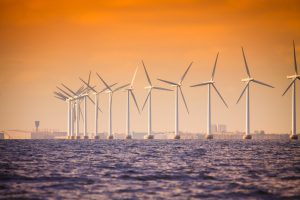By Joel Nelson on January 10, 2020 in Energy News
Here’s a look at some energy milestones from the last time a ’20s decade dawned—a period described by Marquette University economics professor Gene Smiley as “the first truly modern decade.”
Wind. In 1919, two Danish engineers advanced windmills’ state of the art by designing blades that worked like the wings of an airplane. Their “Agricco” could turn to adjust to the wind flow and automatically rotated to face into the wind. A German-developed windmill capable of producing electricity from wind and the U.S.-bred first wind power company followed in 1920 and 1922, respectively. Wind technology was superseded in the 1930s by power lines capable of transmitting electricity to rural areas.

In common with other renewable energy sources, wind experienced a renaissance in the wake of the oil crises of the 1970s. Today, “renewable energy is seeing a boom in growth, with wind energy leading the way” and accounting for nearly 7% of U.S. electricity generation, according to the National Geographic. The World Wind Energy Assn. reports that global capacity for wind turbines reached 600 gigawatts by the end of 2018. There are 57,000 land and offshore wind turbines in the U.S. alone.
Geothermal. At The Geysers, some 70 miles north of San Francisco, molten rock lying relatively close to the Earth’s service heats water in overlying permeable rock to very high temperatures. In 1921 an engineer drilled a geothermal well that powered a generator for lighting a local resort. In 1960, a steam-generated plant at The Geysers began generating electricity commercially.
The Geysers stands today as the world’s largest commercially productive geothermal field. Its average output in 2017 was 647.7 net megawatts.
Geothermal energy—which can be used for heating, cooling and generating electricity—contributes more than 3.7 gigawatts to the national grid, making the U.S. the world’s leader in installed capacity, according to the Department of Energy’s Office of Energy Efficiency & Renewable Energy. Geothermal is used in more than 20 other countries as well. The Philippines and Iceland get around 30% of their electricity production from geothermal power plants.
Solar. Production of a system that enabled heated water to retain its heat prospered during the 1920s but eventually fell victim to market forces: “With the discovery of large amounts of natural gas in California, the cost to heat water plummeted and solar energy systems could no longer compete for business,” according to Maryland power systems designer Solar Energy World.
Meanwhile, Albert Einstein’s 1905 description of the photovoltaic effect—the production of electricity from sunlight—earned the German-born physicist the Nobel Prize in physics in 1921. His work and that of Frenchman Alexandre-Edmond Becquerel, who first demonstrated the photovoltaic effect in 1839, laid the groundwork for solar technology advances.
Solar power proved too costly for commercial use through the 1960s. Then came the 1970s, along with improved capabilities for collecting, storing and delivering solar energy. Solar technology and financing marketplace EnergySage reports that the U.S. surpassed 2 million solar system installations in early 2019, three years after the industry completed its one millionth installation. Reaching that milestone took 40 years. Solar power accounts for enough capacity to power about 9% of U.S. households. Two million more installations are projected to come online by 2023, ratifying solar’s status as what EnergySage calls “the fastest-growing energy resource in the world.”
Electric vehicles. The first successful electric car in the U.S. debuted in 1889; by 1900, 38% of U.S. cars were powered by electricity. As with early solar power and wind technology, this innovation was undermined by a dramatic new development, in this case the mass-produced Ford Model T gasoline-powered car in 1908. In 1912, a gasoline car cost less than 40% of its electric counterpart. And “by the 1920s, the U.S. had a better system of roads connecting cities, and Americans wanted to get out and explore,” says the U.S. Energy Department. Gas was cheap and readily available and filling stations enabled long-distance travel. The initial wave of electric vehicles virtually disappeared by 1935.
Government incentives plus improved technology made electric vehicles viable in the 1990s. As of October 2018, there were more than 1 million electric vehicles on U.S. roads. Those vehicles displaced 323 million gallons of gasoline in 2018, according to the Office of Energy Efficiency & Renewable Energy. The Edison Electric Institute predicts another million EVs by 2021 and 18 million by 2030.
* * *
Easier access to electricity and advanced manufacturing techniques in the 1920s gave rise to radios, phonographs, vacuum cleaners, radios and radio stations, expanded telephone communications capabilities, washing machines and refrigerators. Other influential inventions included the traffic light, penicillin, the bulldozer and liquid-fuel rockets. The U.S. economy grew 42%, accounting for nearly half the world’s output.
Will the 2020s be similarly transformative? Yardi is doing its part to shape the future with industry-leading energy management solutions for real estate. The Balance Sheet will keep a close eye on this young decade’s energy innovations and developments.


